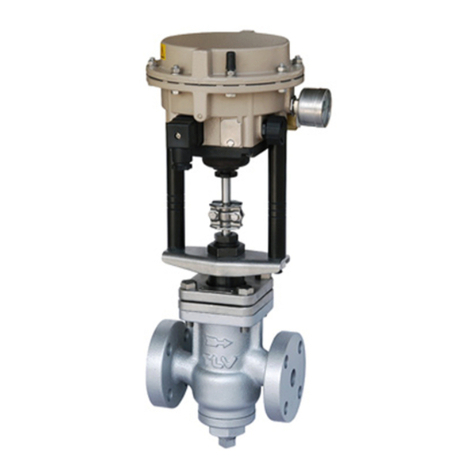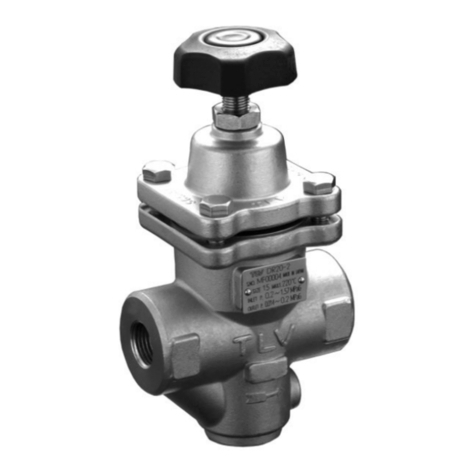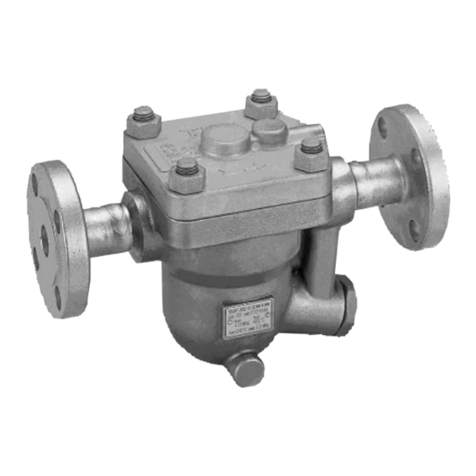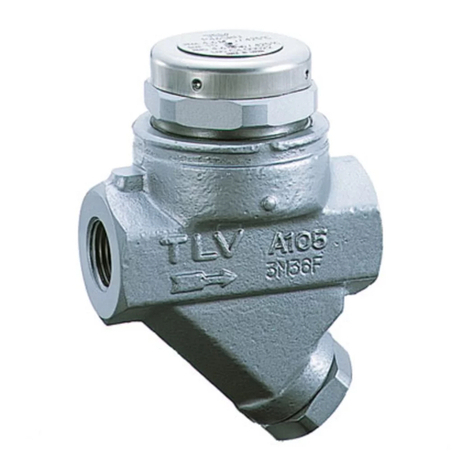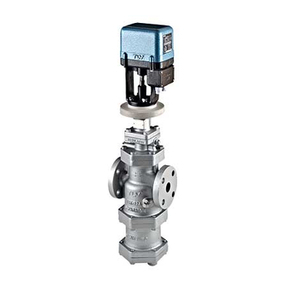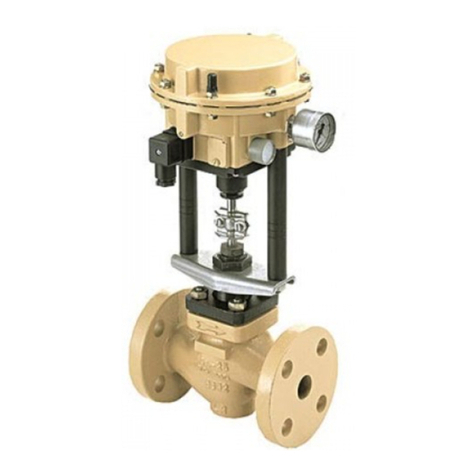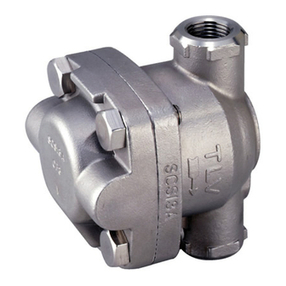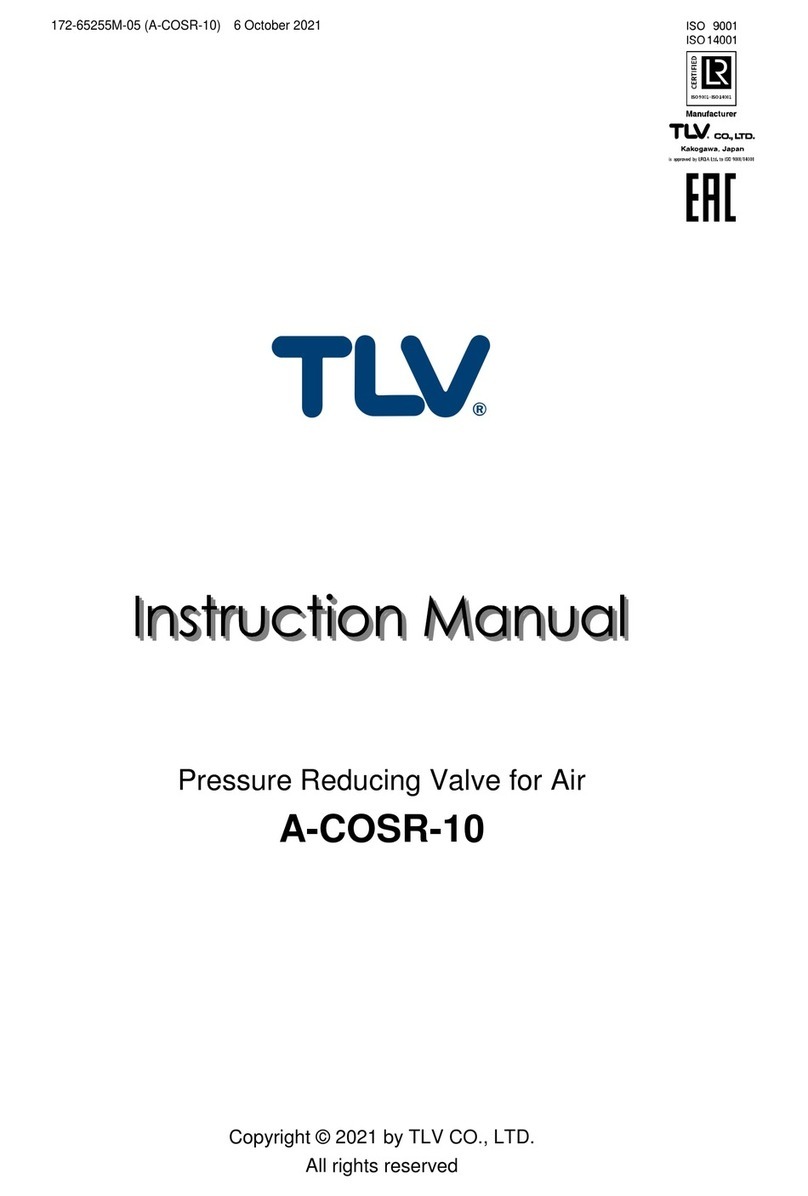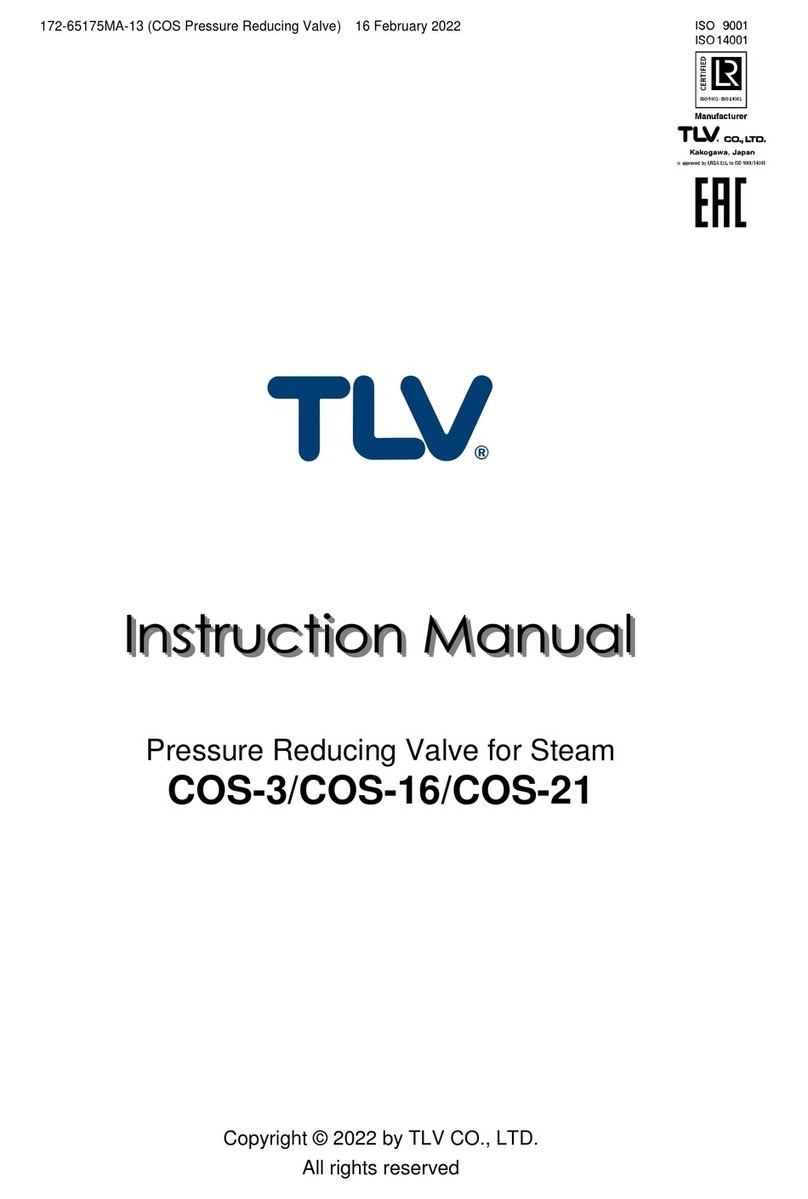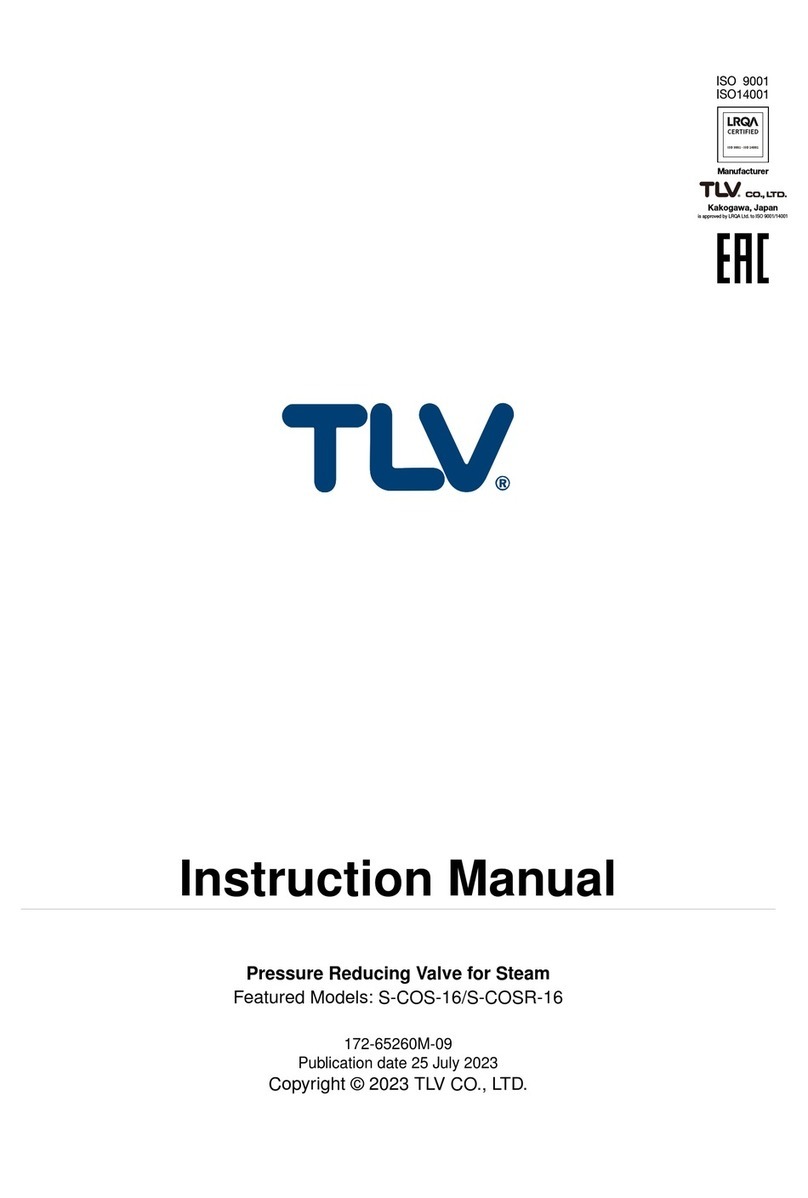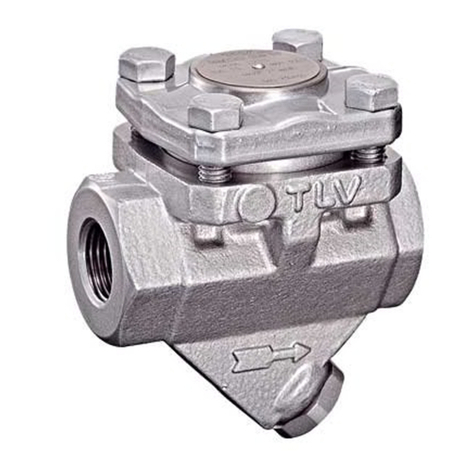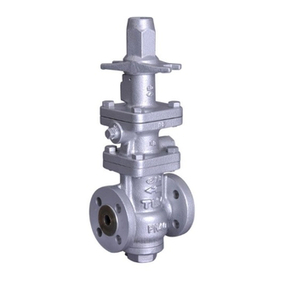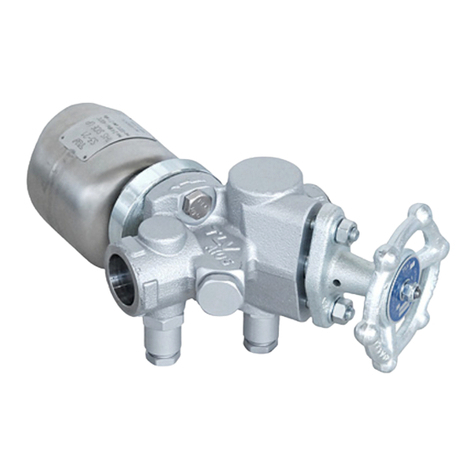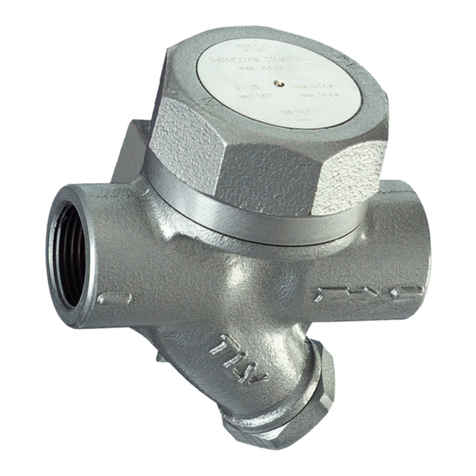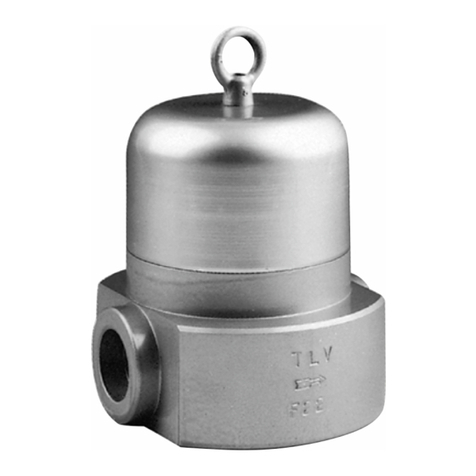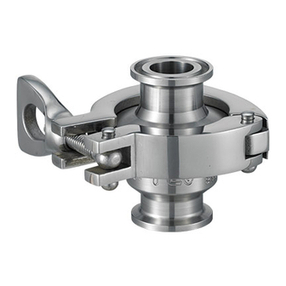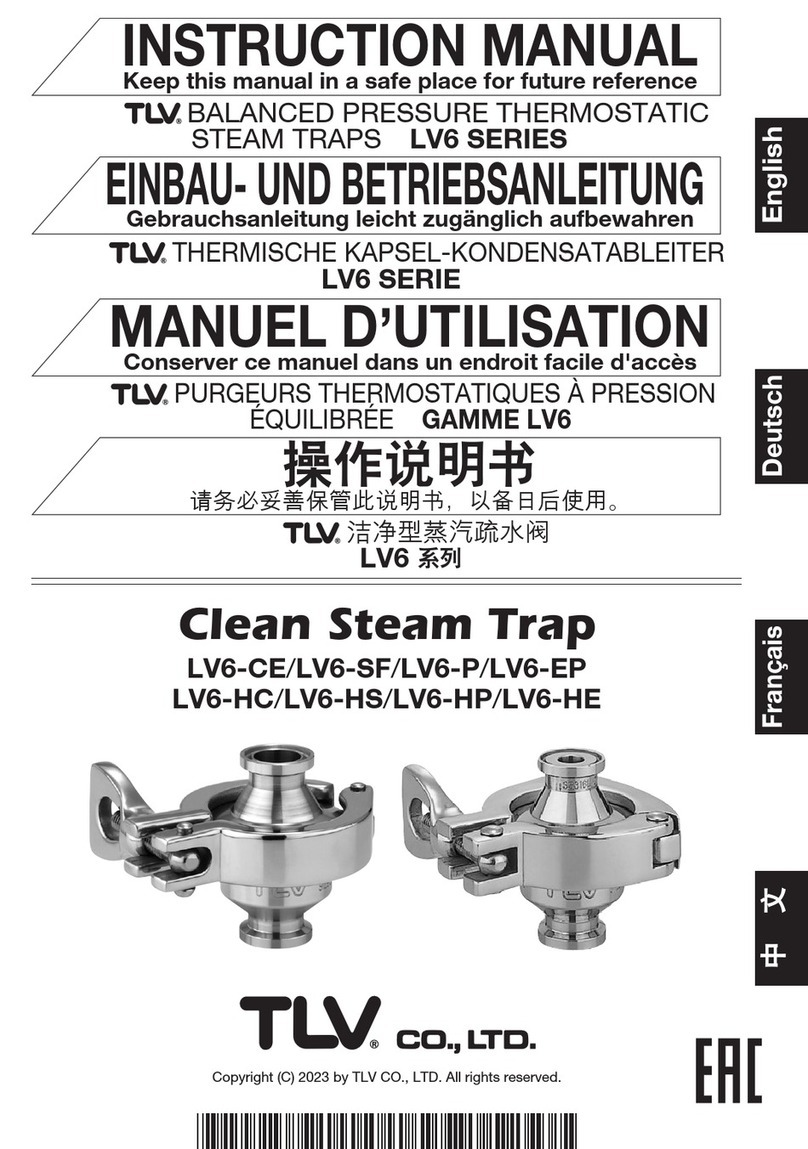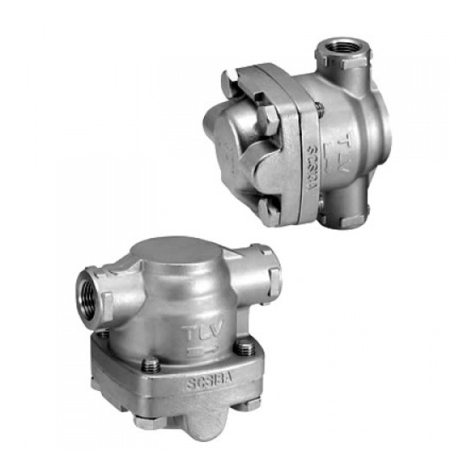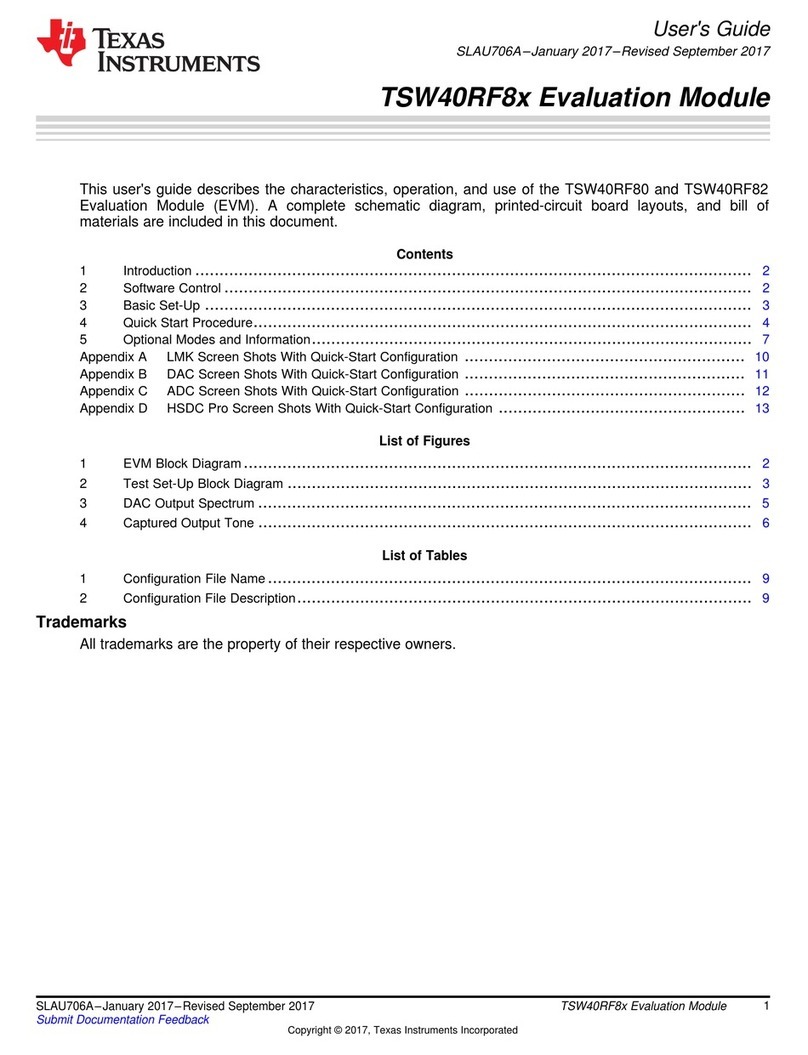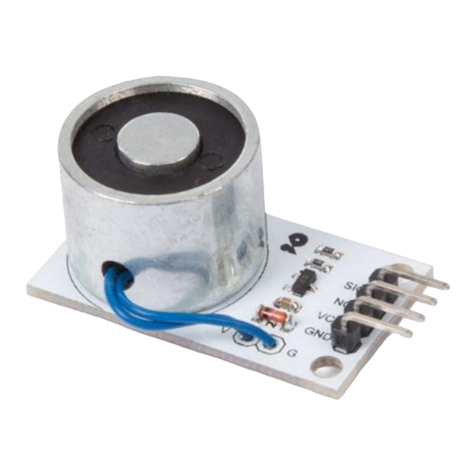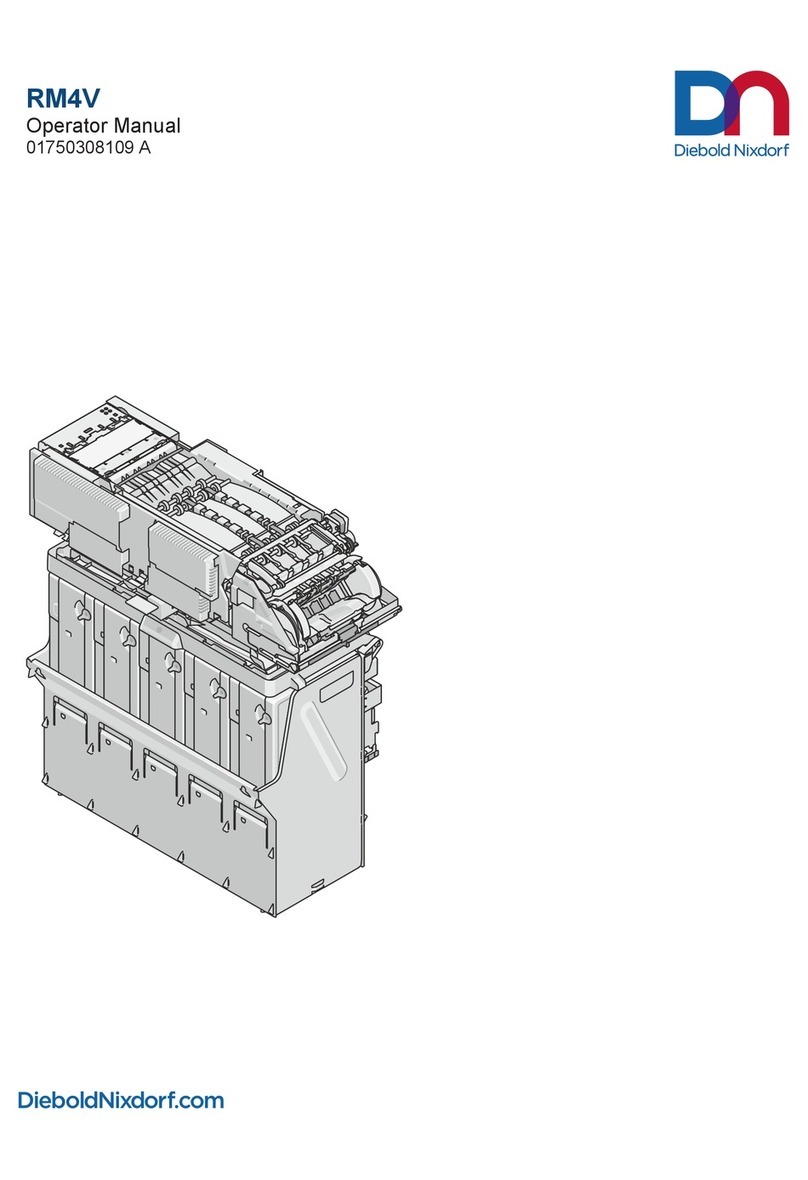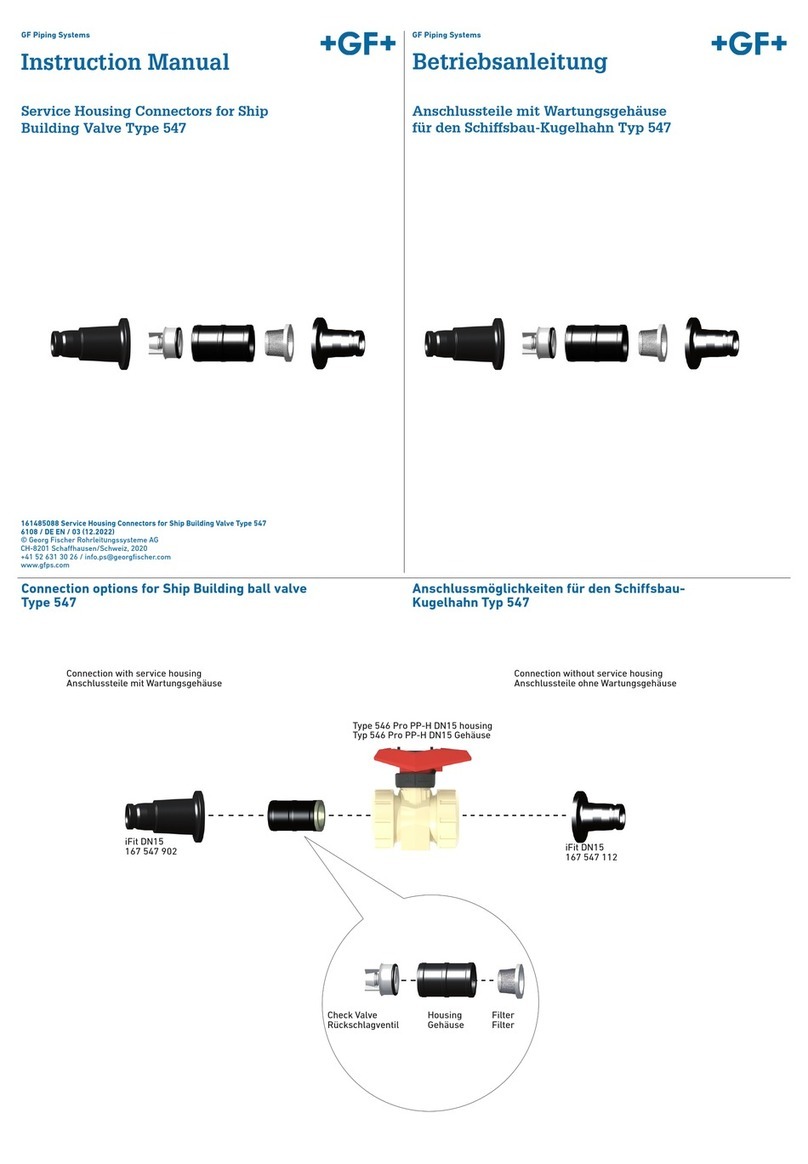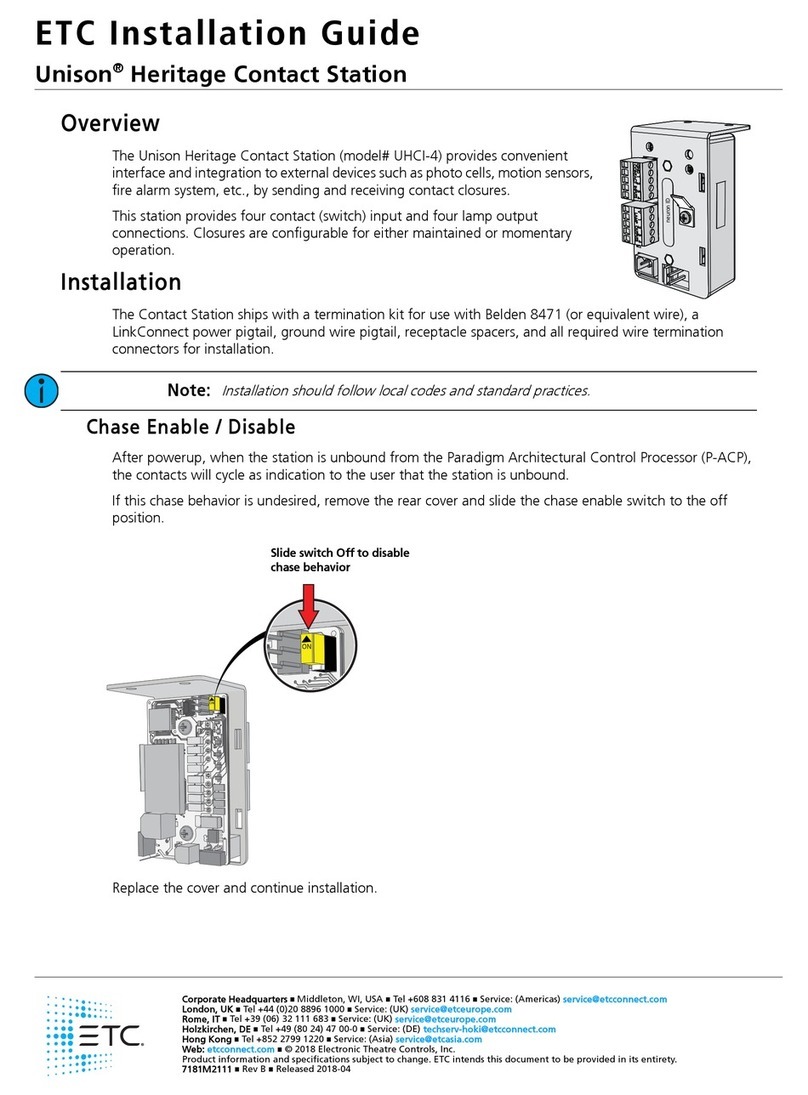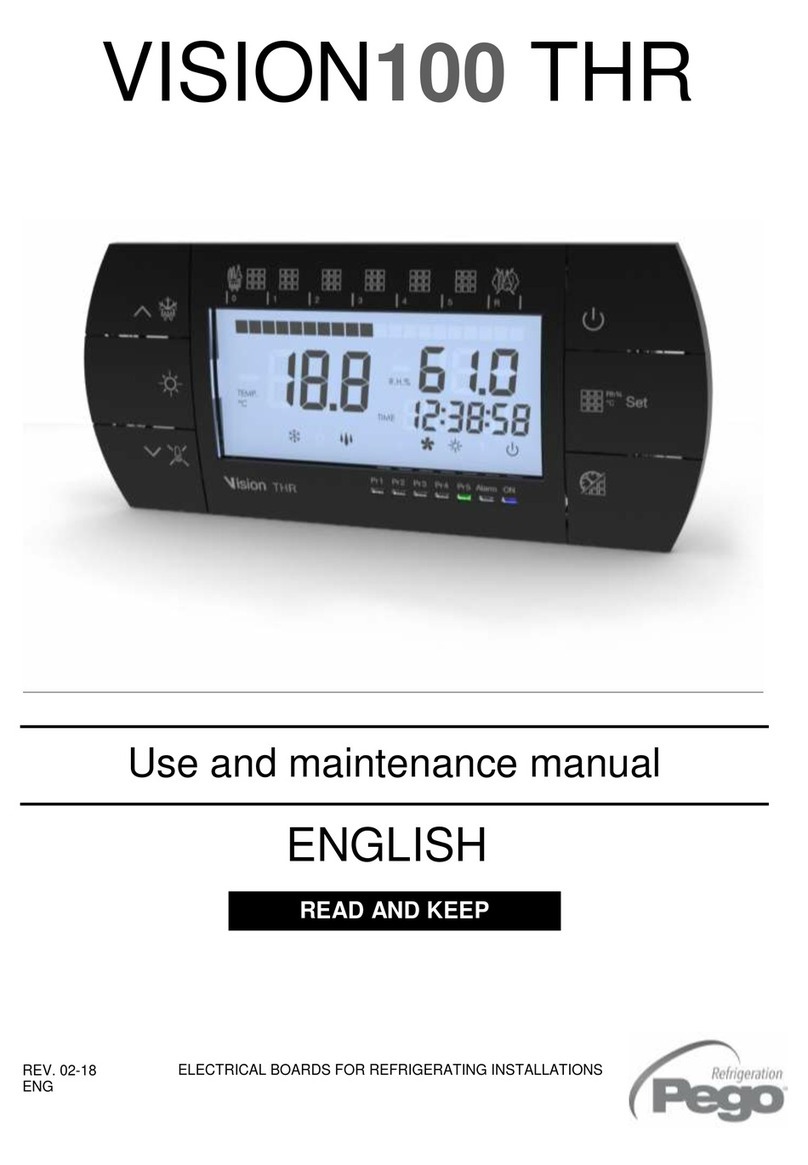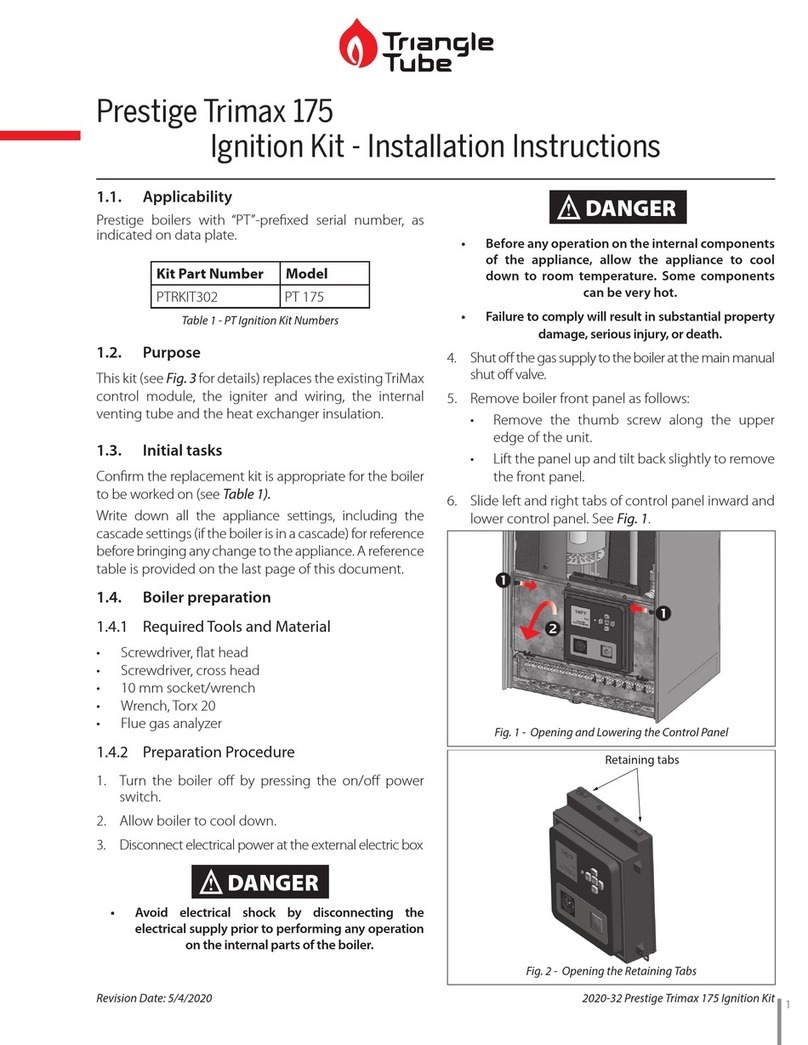TLV SH3NL User manual

+L\[ZJO
-YHUsHPZ
,UNSPZO
-9,,-36(;;@7,:;,(4;9(7:
:/:,90,:
-9,0:*/>044,9265+,5:(;()3,0;,9
:/:,90,
7<9.,<9:+,=(7,<9±-36;;,<9-,94i30)9,
.(44,:/
:/53:/53:/53
:/5/:/5/
:/=3
*VW`YPNO[*I`;3=*V3[K(SSYPNO[ZYLZLY]LK
05:;9<*;0654(5<(3
2LLW[OPZTHU\HSPUHZHMLWSHJLMVYM\[\YLYLMLYLUJL
,05)(<<5+),;90,):(53,0;<5.
.LIYH\JOZHUSLP[\UNSLPJO[a\NpUNSPJOH\MIL^HOYLU
4(5<,3+<;030:(;065
*VUZLY]LYJLTHU\LSKHUZ\ULUKYVP[MHJPSLKHJJuZ

Introduction
Before beginning installation or maintenance, please read this manual to ensure correct
usage of the product. Keep the manual in a safe place for future reference.
The inline repairable steam traps of the SH Series, with thermostatic air vent, are suitable
for applications with pressures up to 10 MPaG* (1500 psig), temperatures up to 425 °C (800 °F),
and under superheat conditions. The traps discharge condensate continuously and
automatically at a temperature slightly lower than saturation temperature.
1 MPa = 10.197 kg/cG, 1 bar = 0.1 MPa
For products with special specifications or with options not included in this manual, contact
TLV for instructions.
The contents of this manual are subject to change without notice.
Einführung
Bitte lesen Sie die Betriebsanleitung vor Einbau und Inbetriebnahme sorgfältig durch und be-
wahren Sie sie für späteren Gebrauch an einem leicht zugänglichen Ort auf.
Die in der Leitung wartbaren Kugelschwimmer-Kondensatableiter der SH Serie, mit thermischem
Entlüfter, können für Betriebsdrücke bis 100 bar ü und Temperaturen bis 425 °C, auch im
überhitzten Bereich, eingesetzt werden. Sie leiten Kondensat automatisch und kontinuierlich mit
geringer Unterkühlung unter Sattdampftemperatur ab.
1 bar = 0,1 MPa
Wenden Sie sich an TLV für Sonderausführungen, die nicht in dieser Einbau- und Betriebs-
anleitung enthalten sind.
Wir behalten uns vor, den Inhalt dieser Betriebsanleitung ohne Ankündigung zu ändern.
Introduction
Veuillez lire attentivement ce manuel afin d'utiliser correctement le produit. Nous vous
recommandons de le garder dans un endroit sûr pour de futures références.
Les purgeurs de vapeur de la gamme SH sont réparables sans les démonter des tuyauteries,
et peuvent être utilisés sans ajustement jusqu'à 100 bar et 425 °C, aussi sous des conditions
surchauffées. Ces modèles évacuent le condensât automatique à une température légèrement
inférieure à la température de saturation.
1 bar = 0,1 MPa
Pour tout produit aux spécifications particulières ou comportant des options non reprises dans ce
manuel, veuillez contacter TLV.
Le contenu de ce manuel est sujet à modifications sans préavis.
―1―
Deutsch
Français
English

English
1. Safety Considerations
―2―
• Read this section carefully before use and be sure to follow the instructions.
• Installation, inspection, maintenance, repairs, disassembly, adjustment and valve
opening/closing should be carried out only by trained maintenance personnel.
• The precautions listed in this manual are designed to ensure safety and prevent equipment
damage and personal injury. For situations that may occur as a result of erroneous handling,
three different types of cautionary items are used to indicate the degree of urgency and the
scale of potential damage and danger: DANGER, WARNING and CAUTION.
• The three types of cautionary items above are very important for safety; be sure to observe
all of them, as they relate to installation, use, maintenance, and repair. Furthermore, TLV
accepts no responsibility for any accidents or damage occurring as a result of failure to
observe these precautions.
Indicates an urgent situation
which poses a threat of
death or serious injury.
Indicates that there is a
potential threat of death
or serious injury.
WARNING
CAUTION
WARNING
DANGER CAUTION
Indicates that there is a
possibility of injury or equip-
ment/product damage.
NEVER apply direct heat to the float. The float may explode due to
increased internal pressure, causing accidents leading to serious injury
or damage to property and equipment.
Install properly and DO NOT use this product outside the
recommended operating pressure, temperature and other
specification ranges. Improper use may result in such hazards as
damage to the product or malfunctions, which may lead to serious
accidents. Local regulations may restrict the use of this product to below
the conditions quoted.
Take measures to prevent people from coming into direct contact
with product outlets. Failure to do so may result in burns or other injury
from the discharge of fluids.
Use hoisting equipment for heavy objects (weighing approximately
20 kg or more). Failure to do so may result in back strain or other injury
if the object should fall.
DO NOT use this product in excess of the maximum operating
pressure differential. Such use could make discharge impossible.
When disassembling or removing the product, wait until the internal
pressure equals atmospheric pressure and the surface of the
product has cooled to room temperature. Disassembling or removing
the product when it is hot or under pressure may lead to discharge of
fluids, causing burns, other injuries or damage.
Be sure to use only the recommended components when repairing
the product, and NEVER attempt to modify the product in any way.
Failure to observe these precautions may result in damage to the product
or burns or other injury due to malfunction or the discharge of fluids.
DO NOT subject this product to condensate loads that exceed its
discharge capacity. Failure to observe this precaution may lead to
condensate accumulation upstream of the trap, resulting in reduced
equipment performance or damage to the equipment.
Use only under conditions in which no freeze-up will occur. Freezing
may damage the product, leading to fluid discharge, which may cause
burns or other injury.
Use under conditions in which no water hammer will occur. The
impact of water hammer may damage the product, leading to fluid
discharge, which may cause burns or other injury.
Do not use excessive force when connecting threaded pipes to the
product. Overtightening may cause breakage leading to fluid discharge,
which may cause burns or other injury.

1. Sicherheitshinweise
• Bitte lesen Sie dieses Kapitel vor Beginn der Arbeiten sorgfältig durch und befolgen Sie die
Vorschriften.
• Einbau und Ausbau, Inspektion, Wartungs- und Reparaturarbeiten, Öffnen/Schließen von
Armaturen, Einstellung von Komponenten, dürfen nur von geschultem Wartungspersonal
vorgenommen werden.
• Die Sicherheitshinweise in dieser Einbau- und Betriebsanleitung dienen dazu, Unfälle,
Verletzungen, Betriebsstörungen und Beschädigungen der Anlagen zu vermeiden. Für
Gefahrensituationen, die durch falsches Handeln entstehen können, werden drei verschiedene
Warnzeichen benutzt: GEFAHR; WARNUNG; VORSICHT.
• Diese drei Warnzeichen sind wichtig für Ihre Sicherheit. Sie müssen unbedingt beachtet werden,
um den sicheren Gebrauch des Produktes zu gewährleisten und Einbau, Wartung und
Reparatur ohne Unfälle oder Schäden durchführen zu können. TLV haftet nicht für Unfälle oder
Schäden, die durch Nichtbeachtung dieser Sicherheitshinweise entstehen.
Bedeutet, dass eine unmittel-
bare Gefahr für Leib und
Leben besteht.
Bedeutet, dass die
Möglichkeit der Gefahr für
Leib und Leben besteht.
VORSICHT
WARNUNG
GEFAHR
WARNUNG
VORSICHT
Bedeutet, dass die Möglichkeit von
Verletzungen oder Schäden an
Anlagen oder Produkten besteht.
Die Schwimmerkugel darf NICHT ERHITZT werden, da sie infolge
erhöhten Innendruckes platzen kann, was schwere Unfälle und
Verletzungen oder Beschädigung von Anlagen zur Folge hat.
Die Einbauhinweise beachten und die spezifizierten Betriebsgrenzen
NICHT ÜBERSCHREITEN. Nichtbeachtung kann zu Betriebsstörungen
oder Unfällen führen. Lokale Vorschriften können zur Unterschreitung der
angegebenen Werte zwingen.
In sicherer Entfernung von Auslassöffnungen aufhalten und andere
Personen warnen, sich fernzuhalten. Nichtbeachtung kann zu
Verletzungen durch austretende Fluide führen.
Bei Schraubanschlüssen keine übermäßige Kraft anwenden, damit
die Gewinde nicht beschädigt werden, was zu Verbrennungen oder
Verletzungen durch austretende Fluide führt.
Nur in frostsicherer Umgebung einsetzen. Einfrieren kann das Produkt
beschädigen, was zu Verbrennungen oder Verletzungen durch
austretende Fluide führt.
Nur an Stellen einbauen, an denen kein Wasserschlag eintreten
kann. Wasserschlag kann das Produkt beschädigen und zu
Verbrennungen oder Verletzungen durch austretende Fluide führen.
Für schwere Werkstücke (ca. 20 kg oder mehr) werden Hebezeuge
dringend empfohlen. Nichtbeachtung kann zu Rückenverletzungen oder
Verletzungen durch das herunterfallende Werkstück führen.
Das Produkt nicht bei Durchsatzmengen über der Nenndurchsatz-
leistung betreiben. Nichtbeachtung kann zu Kondensatrückstau führen
wodurch die Leistung der Anlage beeinträchtigt, oder deren Beschädi-
gung verursacht wird.
Maximalen Differenzdruck NICHT ÜBERSCHREITEN,
da sonst die Kondensatableitung unmöglich werden kann (Blockage).
Vor Öffnen des Gehäuses und Ausbau von Teilen warten, bis der
Innendruck sich auf Atmosphärendruck gesenkt hat und das
Gehäuse auf Raumtemperatur abgekühlt ist. Nichtbeachtung kann zu
Verbrennungen oder Verletzungen durch austretende Fluide führen.
Zur Reparatur nur Original-Ersatzteile verwenden und NICHT
VERSUCHEN, das Produkt zu verändern. Nichtbeachtung kann zu
Beschädigungen führen, die Betriebsstörungen, Verbrennungen oder
andere Verletzungen durch austretende Fluide verursachen.
Deutsch
―3―

9uNSLZKLZtJ\YP[t
3PYLH[[LU[P]LTLU[JL[[LUV[PJLH]HU[S\[PSPZH[PVUL[Z\P]YLSLZPUZ[Y\J[PVUZ
;V\[PUZ[HSSH[PVUPUZWLJ[PVULU[YL[PLUYtWHYH[PVUKtTVU[HNLHQ\Z[LTLU[L[
V\]LY[\YLMLYTL[\YLKL]HUULKVP[v[YLMHP[\UPX\LTLU[WHY\ULWLYZVUULMVYTtLnS»LU[YL[PLU
3HSPZ[LKLZWYtJH\[PVUZnWYLUKYLLZ[t[HISPLHMPUKHZZ\YLY]V[YLZtJ\YP[tL[KLWYt]LUPYKLZ
KtNo[ZTH[tYPLSZL[V\KLZISLZZ\YLZZtYPL\ZLZ+HUZJLY[HPULZZP[\H[PVUZJH\ZtLZWHY\UL
TH\]HPZLTHUPW\SH[PVU[YVPZPUKPJH[L\YZZVU[\[PSPZtZHMPUKPUKPX\LYSLKLNYtK\YNLUJL
StJOLSSLK\KVTTHNLWV[LU[PLSL[SLKHUNLY!+(5.,9(=,9;0::,4,5;L[(;;,5;065
*LZPUKPJH[L\YZZVU[PTWVY[HU[ZWV\Y]V[YLZtJ\YP[t"VIZLY]LaSLZWYtJH\[PVUZKLZtJ\YP[t
tU\TtYtLZKHUZJLTHU\LSWV\YSPUZ[HSSH[PVUS\[PSPZH[PVUSLU[YL[PLUL[SHYtWHYH[PVUK\WYVK\P[
;3=UHJJLW[LH\J\ULYLZWVUZHIPSP[tLUJHZKHJJPKLU[V\KLKVTTHNLZ\Y]LUHU[nSHZ\P[L
K\UUVUYLZWLJ[KLJLZWYtJH\[PVUZ
0UKPX\L\ULZP[\H[PVU
K\YNLUJLH]LJYPZX\LKL
TVY[V\KLISLZZ\YLNYH]L
0UKPX\L\ULZP[\H[PVU
WV\]HU[LU[YHzULYSHTVY[V\
KLZISLZZ\YLZNYH]LZ
(=,9;0::,4,5;
(;;,5;065
(=,9;0::,4,5;
+(5.,9
(;;,5;065
0UKPX\L\UYPZX\LKLISLZZ\YL
V\KLKtNo[TH[tYPLSH\
WYVK\P[L[V\H\_PUZ[HSSH[PVUZ
0UZ[HSSLYSLWYVK\P[JVYYLJ[LTLU[L[5,7(:0\[PSPZLYLUKLOVYZKLSH
WYLZZPVUL[KLSH[LTWtYH[\YLTH_PTHSLZKLMVUJ[PVUULTLU[UPLU
KLOVYZKLZH\[YLZWSHNLZZWtJPMPtLZ<UL[LSSL\[PSPZH[PVUWL\[LU[YHzULY
KLZKVTTHNLZH\WYVK\P[V\KLZK`ZMVUJ[PVUULTLU[ZJLX\PWL\[
WYV]VX\LYKLZIYS\YLZV\H\[YLZISLZZ\YLZ0SZLWL\[X\LKLZYuNSLTLU[Z
SVJH\_SPTP[LU[S\[PSPZH[PVUK\WYVK\P[LUKLsnKLZZWtJPMPJH[PVUZPUKPX\tLZ
5,1(4(0:HWWSPX\LYKLJOHSL\YKPYLJ[LH\MSV[[L\Y3LMSV[[L\YWV\YYHP[
L_WSVZLYZ\P[Ln\ULWYLZZPVUPU[LYULHJJY\LL[JH\ZLYKLZHJJPKLU[Z
WV\]HU[LU[YHzULYKLZISLZZ\YLZZtYPL\ZLZV\KLZKtNo[ZTH[tYPLSZ
7YLUKYLSLZTLZ\YLZHWWYVWYPtLZHMPUK»t]P[LYX\LKLZWLYZVUULZ
U»LU[YLU[LUJVU[HJ[KPYLJ[H]LJSLZV\]LY[\YLZK\WYVK\P[3LUVU
YLZWLJ[KLJL[[LYuNSLWL\[WYV]VX\LYKLZIYS\YLZV\H\[YLZISLZZ\YLZ
ZtYPL\ZLZK\LZnStJV\SLTLU[KLZMS\PKLZ
5LWHZZV\TL[[YLSLW\YNL\YnKLZJOHYNLZKLJVUKLUZo[
Z\WtYPL\YLZnZHJHWHJP[tKL_W\SZPVU3LUVUYLZWLJ[KLJL[[LJVUZPNUL
WL\[LUNLUKYLY\ULHJJ\T\SH[PVUKLJVUKLUZo[LUHTVU[K\W\YNL\YL[
YtK\PYLSLZWLYMVYTHUJLZKLZPUZ[HSSH[PVUZ]VPYLSLZLUKVTTHNLY
,UJHZKLKtTVU[HNLV\KLTHUPW\SH[PVUK\WYVK\P[H[[LUKYLX\L
SHWYLZZPVUPU[LYULZVP[tNHSLnSHWYLZZPVUH[TVZWOtYPX\LL[X\LSH
Z\YMHJLK\WYVK\P[ZVP[JVTWSu[LTLU[YLMYVPKPL3LUVUYLZWLJ[KL
JL[[LYuNSLWL\[WYV]VX\LYKLZIYS\YLZV\H\[YLZKVTTHNLZKZn
StJV\SLTLU[KLZMS\PKLZ
,UJHZKLYtWHYH[PVU\[PSPZLY\UPX\LTLU[SLZJVTWVZHU[ZZWtJPMP
X\LZK\WYVK\P[L[5,1(4(0:,::(@,9KLTVKPMPLYSLWYVK\P[
3LUVUYLZWLJ[KLJL[[LYuNSLWL\[LU[YHzULYKLZKVTTHNLZH\WYVK\P[
V\KLZIYS\YLZL[H\[YLZISLZZ\YLZZtYPL\ZLZK\LZH\K`ZMVUJ[PVUULTLU[
K\WYVK\P[V\nStJV\SLTLU[KLZMS\PKLZ
5»\[PSPZLYX\LKHUZKLZJVUKP[PVUZVSLNLSULZLWYVK\P[WHZ3LNLS
WL\[LUKVTTHNLYSLWYVK\P[L[WYV]VX\LYStJV\SLTLU[KLZMS\PKLZL[
JH\ZLYKLZIYS\YLZV\H\[YLZISLZZ\YLZZtYPL\ZLZ
<[PSPZLYSLWYVK\P[KHUZKLZJVUKP[PVUZVPSU`HH\J\UJV\WKL
ItSPLY3PTWHJ[K\UJV\WKLItSPLYWL\[LUKVTTHNLYSLWYVK\P[L[
WYV]VX\LYS»tJV\SLTLU[KLZMS\PKLZHPUZPX\LKLZIYS\YLZV\KLZ
ISLZZ\YLZNYH]LZ
<[PSPZLYK\TH[tYPLSKLSL]HNLHKtX\H[WV\YSLZVIQL[ZSV\YKZRN
L[WS\Z3LUVUYLZWLJ[KLJL[[LYuNSLWL\[WYV]VX\LYKLZKV\SL\YZ
KHUZSLKVZV\KLZISLZZ\YLZZPSLWYVK\P[]LUHP[n[VTILY
5,7(:\[PSPZLYJLWYVK\P[H]LJ\ULWYLZZPVUKPMMtYLU[PLSSL
Z\WtYPL\YLH\TH_PT\TPUKPX\t3LUVUYLZWLJ[KLJL[[LJVUZPNUL
WV\YYHP[LTWvJOLY[V\[LL_W\SZPVUK\JVUKLUZo[ISVJHNL
5LWHZ\[PSPZLYKLMVYJLL_JLZZP]LSVYZKLSHJVUUL_PVUK\WYVK\P[n
SH[\`H\[LYPL3LUVUYLZWLJ[KLJL[[LYuNSLWL\[WYV]VX\LYSHY\W[\YL
K\WYVK\P[LU[YHzULYnS»tJV\SLTLU[KLZMS\PKLZL[JH\ZLYKLZIYS\YLZ
V\ISLZZ\YLZZtYPL\ZLZ
-YHUsHPZ
4

―5―
Deutsch
Français
English
2. Configuration Aufbau Configuration
SH3NL
SH5NL
SH6NL
SH5NH
SH6NH
SH5VL
6
7
9
4 5
1
382
18
11
14
13
12
16
17
10
15
1 3
6
7
829
15
10 16174 5
12
13
11
14

No.
1
2
3
4
5
6
7
8
9
Body
Cover
Float
Orifice
Orifice Gasket
Air Vent Strip
Screw with Spring Washer
Cover Gasket
Cover Bolt
* M : Maintenance Kit; R : Repair Kit
Float Replacement Replacement floats are available for all SH series models.
Description M* R* No.
10
11
12
13
14
15
16
17
18
Cover Nut
Screen
Screen Holder
Screen Holder Gasket
Flange / Socket
Nameplate
Orifice Plug
Plug Gasket
UP-Seal (SH5VL)
Description M* R*
Nr.
1
2
3
4
5
6
7
8
9
Gehäuse
Gehäusedeckel
Schwimmerkugel
Ventilsitz
Ventilsitzdichtung
Entlüfterbügel
Schraube mit Federring
Gehäusedichtung
Gehäuseschraube
* W : Wartungssatz; R : Reparatursatz
Ersatz-Schwimmerkugel
Für alle Typen der SH Serie sind Ersatz-Schwimmerkugeln erhältlich.
Bauteil W* R* Nr.
10
11
12
13
14
15
16
17
18
Gehäusemutter
Schmutzsieb
Siebhaltestopfen
Dichtung Siebhaltestopfen
Flansch / Muffe
Typenschild
Ventilsitz-Stopfen
Stopfendichtung
UP-Schild (SH5VL)
Bauteil W* R*
No.
1
2
3
4
5
6
7
8
9
Corps
Couvercle
Flotteur
Orifice
Joint d'orifice
Bilame purge d'air
Vis et rondelle de ressort
Joint de couvercle
Boulon de couvercle
* E : Jeu de pièces d'entretien; R : Jeu de pièces de réparation
Remplacement du flotteur Un remplacement du flotteur est disponible pour toutes les modèles
de la gamme SH.
Désignation E* R* No.
10
11
12
13
14
15
16
17
18
Écrou de couvercle
Crépine
Porte-crépine
Joint porte-crépine
Bride / Tubulure
Plaquette nominative
Bouchon d’orifice
Joint de bouchon
Étiquette UP (SH5VL)
Désignation E* R*
Français
Deutsch
English
―6―

7
:WLJPMPJH[PVUZ;LJOUPZJOL+H[LU+VUUtLZ[LJOUPX\LZ
+PL,PUIH\OPU^LPZLILHJO[LU\UKKPLZWLaPMPaPLY[LU)L[YPLIZNYLUaLU50*/;
l),9:*/9,0;,55PJO[ILHJO[\UNRHUUa\)L[YPLIZZ[Y\UNLUVKLY
<UMpSSLUMOYLU3VRHSL=VYZJOYPM[LURUULUa\Y<U[LYZJOYLP[\UNKLY
HUNLNLILULU>LY[La^PUNLU
=69:0*/;
0UZ[HSSLYSLWYVK\P[JVYYLJ[LTLU[L[5,7(:0\[PSPZLYLUKLOVYZKLZWSHNLZ
ZWtJPMPtLZ,UJHZKLKtWHZZLTLU[KLZSPTP[LZKVUUtLZKLZ
K`ZMVUJ[PVUULTLU[ZV\HJJPKLU[ZWV\YYHPLU[Z\Y]LUPY0SZLWL\[X\LKLZ
YuNSLTLU[ZSVJH\_SPTP[LU[S\[PSPZH[PVUK\WYVK\P[LUKLsnKLZ
ZWtJPMPJH[PVUZPUKPX\tLZ
(;;,5;065
;VH]VPKTHSM\UJ[PVUZWYVK\J[KHTHNLHJJPKLU[ZVYZLYPV\ZPUQ\Y`
PUZ[HSSWYVWLYS`HUK+656;\ZL[OPZWYVK\J[V\[ZPKL[OLZWLJPMPJH[PVU
YHUNL3VJHSYLN\SH[PVUZTH`YLZ[YPJ[[OL\ZLVM[OPZWYVK\J[[VILSV^[OL
JVUKP[PVUZX\V[LK
*(<;065
9LMLY[V[OLWYVK\J[UHTLWSH[LMVYKL[HPSLKZWLJPMPJH[PVUZ
+PL[LJOUPZJOLU+H[LUZ[LOLUH\MKLT;`WLUZJOPSK
3LZKVUUtLZ[LJOUPX\LZZVU[PUZJYP[LZZ\YSHWSHX\L[[LUVTPUH[P]L
4H_PT\THSSV^HISLWYLZZ\YL74(HUKTH_PT\THSSV^HISL[LTWLYH[\YL;4(HYL
79,::<9,:/,33+,:0.5*65+0;065:56;67,9(;05.*65+0;065:
¸=HS]L5V¹PZKPZWSH`LKMVYWYVK\J[Z^P[OVW[PVUZ;OPZP[LTPZVTP[[LKMYVT[OL
UHTLWSH[L^OLU[OLYLHYLUVVW[PVUZ
4H_PTHSa\SpZZPNLY+Y\JR74(\UKTH_PTHSa\SpZZPNL;LTWLYH[\Y;4(ZPUK
(<:3,.<5.:+(;,550*/;),;90,):+(;,5
+PL=HS]L5V^PYKHUNLNLILUILP;`WLUTP[6W[PVULU)LP;`WLUVOUL6W[PVULUISLPI[
KPLZL:[LSSLMYLP
7YLZZPVUTH_PTHSLHKTPZZPISL74(L[[LTWtYH[\YLTH_PTHSLHKTPZZPISL;4(ZVU[SLZ
*65+0;065:+,*65*,7;0657(:3,:*65+0;065:+,-65*;0655,4,5;
3L=HS]L5VLZ[PUKPX\tZ\YSLZTVKuSLZH]LJVW[PVUZ*LU\TtYVULMPN\YLWHZZ\YSLZ
TVKuSLZZHUZVW[PVUZ
.7YVK\J[PVU3V[5V
-LY[PN\UNZSVZ5Y
3V[KL7YVK\J[PVU5
/=HS]L5V
*4H_PT\T(SSV^HISL7YLZZ\YL
4H_PTHSa\SpZZPNLY+Y\JR
7YLZZPVUTH_PTHSLHKTPZZPISL
- 4H_PT\T6WLYH[PUN;LTWLYH[\YL
4H_PTHSL)L[YPLIZ[LTWLYH[\Y
;LTWtYH[\YLKLMVUJ[PVUULTLU[TH_PTHSL
+4H_PT\T(SSV^HISL;LTWLYH[\YL;4(
4H_PTHSa\SpZZPNL;LTWLYH[\Y;4(
;LTWtYH[\YLTH_PTHSLHKTPZZPISL;4(
(4VKLS
;`W
4VKuSL
,4H_PT\T+PMMLYLU[PHS7YLZZ\YL
4H_PTHSLY+PMMLYLUaKY\JR
7YLZZPVUKPMMtYLU[PLSSLTH_PTHSL
)5VTPUHS+PHTL[LY
.YL+5
+PTLUZPVU+5
(SSL_JLW[:/53(SSLH\LY:/53
;V\ZZH\M:/53
:/53
)
(
.
+
,
/
*
-
(
+
,
/
*
)
-
.
+L\[ZJO
-YHUsHPZ
,UNSPZO

GroundGroundGround
―8―
English
Allowable Inclination
SH3NL / SH5NL / SH6NL / SSH5NH / SH6NH
SH5VL
1.
Before installation, be sure to remove all protective seals.
2. Install the trap within the allowable inclination, as shown below. Also make sure that the
arrow mark on the body corresponds with the direction of flow.
3.
Before installing the trap, blow out the inlet piping to remove all dirt and oil.
4.
Install the trap in the lowest part of the pipeline or equipment so the condensate
flows naturally downward into the trap by gravity. The inlet pipe should be as short
and have as few bends as possible.
5.
Support the pipes properly within 0.8 meters (2.5 ft.) on either side of the trap.
6.
Install a bypass valve to discharge condensate, and inlet and outlet valves to
isolate the trap in the event of trap failure or when performing maintenance.
7.
Install a check valve at the trap outlet whenever more than one trap is connected to
the condensate collection pipeline.
8.
We recommend unions to facilitate connection and disconnection of the screwed version.
4. Proper Installation
• Installation, inspection, maintenance, repairs, disassembly, adjustment
and valve opening/closing should be carried out only by trained
maintenance personnel.
• Take measures to prevent people from coming into direct contact with
product outlets.
• Use hoisting equipment for heavy objects.
• Install for use under conditions in which no freeze-up will occur.
• Install for use under conditions in which no water hammer will occur.
CAUTION
Screen Holder Arrow Reference Level
Direction of
Inlet Flow
The face of the screen holder perpendicular to the ground, and the
inlet and outlet horizontal to the ground.
IMPORTANT! (For screwed connection)
To prevent rotation due to vibration,
secure trap in position by supporting
the body at the point marked▲
Nameplate Face
Center of Piping
Perpendicular
Parallel
5˚5˚
5˚5˚
5˚5˚
Direction of
Inlet Flow
From Top
GroundGroundGround

―9―
English
1. Is the pipe diameter suitable?
2. Has the trap been installed within the allowable inclination and with the arrow on the body
pointing in the direction of flow?
3. Has sufficient space been secured for maintenance?
4. Have maintenance valves been installed at inlet and outlet? If the outlet is subject to
back pressure, has a check valve been installed?
5. Is the inlet pipe as short as possible, with as few bends as possible, and installed so that the
condensate will flow naturally down into the trap?
6. Has the piping work been done with the proper methods as shown in the table above?
Check to make sure that the pipes connected to the trap have been installed properly.
5. Piping Arrangement
Requirement
Install a catchpot with the
proper diameter.
Diameter is too
small.
Diameter is too
small and inlet
protrudes into pipe.
Rust and scale
flow into the trap
with the
condensate.
Condensate
collects in the
pipe.
Make sure the flow of
condensate is not obstructed.
To prevent rust and scale
from flowing into the trap,
connect the inlet pipe
25 - 50 mm (1 - 2 in) above
the base of the T - pipe.
When installing on the
blind end, make sure
nothing obstructs the flow
of condensate.
Correct Incorrect

―10―
English
During Disassembly During Reassembly
Remove gasket and clean sealing
surfaces Replace with a new gasket, coat
surfaces with anti-seize
Remove without bending Reinstall without bending
Remove, being careful not to scratch
sealing surfaces of body and cover
Make sure there are no pieces of old gasket
left on the sealing surface of body and
cover, then reattach
Insert into body, being careful not to
scratch its polished surface
Remove gasket and clean sealing
surfaces of cover and body
Remove only if corroded or
damaged
Reinstall with a Phillips screwdriver, then
tighten to the proper torque
Reattach without bending
Coat threads with anti-seize, then tighten
to the proper torque
Replace with a new gasket, do not apply
anti-seize
Remove, being careful not to scratch
its polished surface
Replace with a new bolt if corroded or
damaged
Replace with a new gasket, do not
apply anti-seize
Remove with a Phillips screwdriver
Remove without bending
Remove with a socket wrench
Remove gasket and clean sealing
surfaces
Coat threads with anti-seize, then tighten
to the proper torque
Remove with a hex wrench.
Part & No.
Screen Holder
Gasket 13
Screen 11
Cover 2
Cover Gasket 8
Float 3
Screw with Spring
Washer 7
Air Vent Strip 6
Orifice 4
Orifice Gasket 5
Coat threads with anti-seize, then tighten
to the proper torque
Remove with a socket wrenchPlug 16
Replace with a new gasket, coat surfaces
with anti-seize
Remove gasket and clean sealing
surfaces
Plug Gasket 17
Cover Bolt 9
Cover Nut 10
Remove with a socket wrench Coat threads with anti-seize, then tighten
to the proper torque
Screen
Holder 12
Disassembly/Reassembly (to reassemble, follow procedures in reverse)
Operational inspections should be performed at least twice per year, or as called for by trap
operating conditions. Steam trap failure may result in a temperature drop in the equipment, poor
product quality or losses due to steam leakage.
6. Inspection and Maintenance
WARNING
NEVER apply direct heat to the float. The float may explode due to
increased internal pressure, causing accidents leading to serious injury or
property and equipment damage.
• Installation, inspection, maintenance, repairs, disassembly, adjustment
and valve opening/closing should be carried out only by trained
maintenance personnel.
• Before attempting to open the trap, close the inlet and outlet isolation valves and wait until the
trap has cooled completely. Failure to do so may result in burns.
• Be sure to use the proper components and NEVER attempt to modify the product.
CAUTION
Body, Cover
Gaskets
Air Vent Strip
Screen
Float
Orifice
Check inside for damage, dirt, grease, oil film, rust or scale
Check for warping or damage
Check for damage
Check for clogging, corrosion or damage
Check for deformation, damage, oil film or water inside
Check for rust, scale, oil film, wear or damage
Parts Inspection Procedure

Cover Nut Orifice
Tightening Torque and Distance Across Flats
Model
SH3NL
SH5NL
SH6NL
SH5NH
SH6NH
SH5VL
N•m
(lbf•ft) N•m
(lbf•ft) N•m
(lbf•ft) N•m
(lbf•ft) N•m
(lbf•ft) mm
(in)
mm
(in)
mm
(in)
mm
(in)
mm
(in) mm
(in)
60
(44)
120
(88)
130
(95)
150
(110)
370
(270)
120
(88)
60
(44)
80
(59)
200
(150)
100
(73)
220
(160)
80
(59)
17
(1 )
/
16
3
22
( )
/
8
7
22
( )
/
8
7
( )
/
8
7
( )
/
8
7
22
30
22
(1 )
/
16
3
(1 )
/
16
3
( )
/
16
13
19
( )
/
4
3
30
( )
/
4
3
21
30
19
200
(150)
200
(150)
400
(290)
200
(150)
400
(290)
300
(220)
200
(150) 0.3
(0.2)
0.3
(0.2)
0.3
(0.2)
0.3
(0.2)
0.3
(0.2)
0.3
(0.2)
200
(150)
200
(150)
200
(150)
200
(150)
200
(150)
38
(1 )
/
2
1
(1 )
/
2
1
(1 )
/
2
1
(1 )
/
2
1
38
38
38
38
(1 )
/
2
1
(1 )
/
2
1
(1 )
/
2
1
(1 )
/
2
1
38
38
(1 )
/
2
1
38
(1 )
/
2
1
38
38
Orifice Plug Screen Holder Screw
+
+
+
+
+
+
1 N·m 10 kg·cm
〜
〜
7. Exploded View
Cover nut
Cover bolt
Air vent strip
Cover
Flange / Socket
Float
Orifice
Screen Screen
holder
Screen holder gasket
Plug gasket
Screw with
spring washer
Orifice
gasket Body
Plug
Cover gasket
Nameplate
17
( )
/
32
21 ( )
/
32
21
50
(1 )
/
32
31
50
(2)
If drawings or other special documentation were supplied for the product, any torque given there
takes precedence over values shown here.
English
―11―

―12―
English
8. Operational Check
Normal: Condensate is discharged continuously with flash steam and the sound
of flow can be heard. If there is very little condensate, there is almost no
sound of flow.
Blocked:
Discharge
lmpossible
No condensate is discharged. The trap is quiet and makes no noise,
and the surface temperature of the trap is low.
Blowing: Live steam continually flows from the outlet and there is a continuous
metallic sound.
Live steam is discharged through the trap outlet together with the
condensate and there is a high-pitched sound.
A visual inspection can be carried out to aid in determining the necessity for immediate
maintenance or repair, if the trap is open to atmosphere. If the trap does not discharge to
atmosphere, use diagnostic equipment such as TLV TrapMan or TLV Pocket TrapMan (within its
pressure and temperature measurement range).
Flash Steam
White jet
containing
water droplets
Live Steam Leakage
Clear, slightly
bluish jet
(When conducting a visual inspection, flash steam is sometimes mistaken for steam leakage. For
this reason, the use of a steam trap diagnostic instrument such as TLV TrapMan is highly
recommended.)
Steam
Leakage:

Instructions for Plug / Holder Disassembly and Reassembly
The seal on the threaded plugs/holders found on TLV products is formed by a flat metal
gasket. There are various installation orientations for the gaskets, such as horizontal,
diagonal and downward, and the gasket may be pinched in the thread recesses during
assembly.
Instructions for Disassembly and Reassembly
1Remove the plug/holder using a tool of the specified
size (distance across flats).
2The gasket should not be reused. Be sure to
replace it with a new gasket.
3Clean the gasket surfaces of the plug/holder and the
product body using a rag and/or cleaning agents, then
check to make sure the surfaces are not scratched or
deformed.
4Coat both the gasket surface of the plug/holder and
the threads of the plug/holder with anti-seize, then
press the gasket onto the center of the gasket
surface of the plug/holder, making sure the
anti-seize affixes the gasket tightly to the
plug/holder. Check to make sure the gasket is not
caught in the recesses of the threads.
5Hold the plug/holder upside down to make sure that
the anti-seize makes the gasket stick to the
plug/holder even when the plug/holder is held
upside down.
6Screw the plug/holder by hand into the product body
while making sure that the gasket remains tightly
affixed to the center of the gasket surface of the
plug/holder. Make sure the entire gasket is making
contact with the gasket surface of the product body.
It is important at this point to make sure the gasket
is not pinched in the thread recesses of the
plug/holder.
7Tighten the plug/holder to the proper torque.
8 Next, begin the supply of steam and check to make sure there is no leakage from the part
just tightened. If there is leakage, immediately close the inlet valve and, if there is a bypass
valve, take the necessary steps to release any residual pressure. After the surface of the
product cools to room temperature, repeat the procedure beginning from step 1.
3
5
6
Gasket
Do not pinch gasket
in thread recesses
4Coat with anti-seize
Gasket Surface
―13―
English

―14―
9. Troubleshooting
If the expected performance is unachievable after installation of the steam trap, read chapters 4
and 5 again, and check the following points for the appropriate corrective measures.
Problem
No condensate
is discharged
(blocked) or
discharge is
poor
Steam is
discharged
or leaks from
the trap outlet
(blowing)
(Steam leakage)
Steam leaks from
a place other
than the trap
outlet
Float is damaged or filled with
condensate
The trap operating pressure exceeds
the maximum specified pressure, or
there is insufficient differential pressure
between the trap inlet and outlet
Compare specifications and actual
operating conditions
Steam locking has occurred
Flow exceeds trap’s rated capacity
Blowdown through the bypass or
close the trap inlet valve and allow
the trap to cool
Check specifications and reselect
trap suitable for actual flow
Clean
Deterioration of or damage to gaskets Replace with new gaskets
Float is
frequently
damaged
Water hammer occurs Examine the piping for problems that
can cause water hammer
Scratches on the orifice Replace with a new orifice
Float is deformed or coated with scale Clean or replace the float
Trap is installed above the maximum
allowable inclination angle Correct the installation
Vibration of trap occurs Lengthen inlet piping, then fasten it
securely
The air vent strip is damaged Replace with a new air vent strip
Replace with new float
Cause Remedy
The float is sticking to the orifice
Tighten to the proper torque
Orifice, screen or piping is clogged
with rust or scale
Rust and scale have accumulated
around the orifice or under the float
Clean
Clean
NOTE: when replacing parts with new, use the parts list for reference, and replace with parts
from the Maintenance Kit, Repair Kit, etc. Please note that replacement parts are only available as
part of a replacement parts kit.
Improper tightening torque on cover
nuts was used
English

1.
Vor dem Einbau die Transport-Schutzkappen entfernen.
2. Der Kondensatableiter ist so einzubauen, dass die nachfolgend gezeigten Schräg-
lagentoleranzen nicht überschritten werden und der Pfeil auf dem Gehäuse in Durch-
flussrichtung zeigt.
3.
Vor Einbau Leitung durchblasen, um Öl und Verschmutzungen zu entfernen.
4.
Die Zuführleitung sollte kurz sein, so wenig Krümmer wie möglich aufweisen und ist so zu
verlegen, dass das Kondensat durch Schwerkraftwirkung dem Kondensatableiter zufließen
kann.
5.
Die Kondensatleitung muss im Abstand von maximal 800 mm vor und hinter dem
Kondensatableiter abgestützt werden.
6.
Um Wartung und Inspektion zu erleichtern, wird der Einbau von Absperrorganen
vor und hinter dem Kondensatableiter empfohlen. Auch sollte eine Umgehungs-
leitung zur Notentwässerung vorgesehen werden.
7.
Falls die Auslassleitung in einen Tank oder eine Kondensatrückführleitung mündet,
oder falls mehrere Kondensatableiter an eine gemeinsame Leitung angeschlossen sind,
muss ein Rückschlagventil hinter jedem Kondensatableiter eingebaut werden.
8.
Bei Einsatz eines Typs mit Muffenanschluss wird empfohlen, Rohrverschraubungen davor
und dahinter anzubringen.
4. Einbauhinweise
•
Einbau und Ausbau, Inspektion, Wartungs- und Reparaturarbeiten,
Öffnen/Schließen von Armaturen, Einstellung von Komponenten dürfen nur
von geschultem Wartungspersonal vorgenommen werden.
•
In sicherer Enfernung von Auslassöffnungen aufhalten und andere Personen
warnen, sich fernzuhalten.
•
Für schwere Werkstücke müssen geeignete Hebezeuge verwendet werden.
•
Kondensatableiter in frostsicherer Umgebung einbauen.
•
Kondensatableiter nur dort einbauen, wo kein Wasserschlag eintreten
kann.
VORSICHT
Schräglagentoleranz
5˚ 5˚5˚
5˚
Siebhaltestopfen Pfeil
Senkrecht
Bezugsebene
Oberfläche
Typenschild
Mittellinie Rohrleitung
Durchflussrichtung
Durchflussrichtung
von oben
SH5VL
Stirnfläche des Siebhaltestopfens senkrecht und
Einlass-Auslass horizontal zur Grundfläche.
WICHTIG! (Bei Muffenanschluss)
Um zu vermeiden, dass sich der Konden-
satableiter wegen Vibration in der Muffe
dreht, muss er an der mit▲angegebenen
Stelle abgestützt werden.
SH3NL / SH5NL / SH6NL / SSH5NH / SH6NH
Parallel
GrundflGrundflächecheGrundfläche
GrundflGrundflächecheGrundfläche
5˚5˚
―15―
Deutsch

5. Rohrleitungsführung
Vorschrift
Kondensatstutzen mit
ausreichendem Durchmesser
einbauen.
Durchmesser
zu klein.
Durchmesser zu klein
und Abflussrohr ragt in
Rohrleitung hinein.
Rost und sonstige
Ablagerungen gelangen
mit dem Kondensat in
den KA.
Kondensat
sammelt sich in
Rohrleitung an.
Für ungehinderten
Kondensatzufluss
sorgen.
Um Rost und sonstige Ab-
lagerungen vom KA fernzuhalten
muss die Zuleitung 25 ~ 50 mm
über dem Deckel des Stutzens
angeschlossen werden.
Bei Einbau an Leitungsenden ist
die nebenstehende Anschlussart
vorzusehen, damit das Kondensat
ungehindert abfließen kann.
Richtig Falsch
1. Ist die Nennweite groß genug?
2. Wurde der Kondensatableiter horizontal, bzw. innerhalb der Schräglagentoleranz und mit
dem Pfeil in Durchflussrichtung eingebaut?
3. Ist genügend Platz für Wartungsarbeiten vorhanden?
4. Wurden vor und hinter dem Kondensatableiter Absperrarmaturen eingebaut? Falls
Gegendruck besteht, wurde ein Rückschlagventil eingebaut?
5. Ist die Zuleitung so kurz wie möglich, hat sie so wenig Krümmer wie möglich und kann
das Kondensat durch Schwerkraft zufließen?
6. Wurden die Rohrleitungen so ausgeführt, wie oben beschrieben?
Stellen Sie sicher, dass die Rohrleitungsarbeiten richtig ausgeführt wurden und dass der
Kondensatableiter wie beschrieben, eingebaut wurde.
―16―
Deutsch

Gehäuse, Deckel
Dichtungen
Entlüfterbügel
Schmutzsieb
Schwimmerkugel
Ventilsitz
Auf Ablagerungen, Rost, Schmutz, Ölfilm prüfen
Auf Verformung oder Beschädigung prüfen
Auf Beschädigung prüfen
Auf Verstopfung, Ablagerungen, Beschädigung prüfen
Auf Verformung, Beschädigung oder Wasser in der Kugel prüfen
Auf Ablagerungen, Rost, Schmutz, Ölfilm prüfen
Überprüfung der Einzelteile
Es wird empfohlen, mindestens zweimal pro Jahr oder, je nach Betriebsweise, in kürzeren
Zeitabständen eine Inspektion durchzuführen.
6. Inspektion und Wartung
WARNUNG
Um Unfälle und Verletzungen zu vermeiden, darf die Schwimmerkugel
NICHT ERHITZT WERDEN, da sie infolge erhöhten Innendrucks platzen
kann.
•
Einbau und Ausbau, Inspektion, Wartungs- und Reparaturarbeiten,
Öffnen/Schließen von Armaturen, Einstellung von Komponenten dürfen nur
von geschultem Wartungspersonal vorgenommen werden.
• Vor dem Öffnen des Kondensatableiters sind die Absperrarmaturen auf beiden Seiten zu
schließen. Gehäuse auf Raumtemperatur abkühlen lassen. Nichtbeachtung kann zu
Verbrennungen führen.
• Zur Reparatur nur Original-Ersatzteile verwenden NICHT das Produkt verändern.
VORSICHT
Ausbau Einbau
Dichtung entfernen und Dichtflächen
reinigen Dichtung erneuern, Dichtflächen mit
Schmiermittel bestreichen
Herausheben ohne zu verbiegen Einsetzen ohne zu verbiegen
Gehäusedeckel abheben,
Dichtflächen nicht zerkratzen
Reste von alter Dichtung an den
Dichtflächen von Deckel und
Gehäuse entfernen
Vorsichtig einsetzen, feingeschliffene
Oberfläche nicht zerkratzen
Dichtung entfernen und Dichtflächen
reinigen
Nur abschrauben falls korrodiert
oder beschädigt
Mit Schraubenzieher anschrauben,
Anzugsmoment beachten
Einsetzen ohne zu verbiegen
Gewinde schmieren, Anzugsmoment
beachten
Dichtung erneuern, kein Schmiermittel
verwenden
Vorsichtig herausheben, feinge-
schliffene Oberfläche nicht zerkratzen
Bolzen ersetzen falls korrodiert oder
beschädigt
Dichtung erneuern, kein Schmiermittel
verwenden
Mit Schraubenzieher abschrauben
Abnehmen ohne zu verbiegen
Ringschlüssel verwenden
Dichtung entfernen und Dichtflächen
reinigen
Gewinde schmieren Anzugsmoment
beachten
Gabel-oder Ringschlüssel
verwenden
Bauteil & Nr.
Stopfen-
dichtung 13
Schmutzsieb 11
Gehäuse-
bolzen 9
Gehäuse-
deckel 2
Gehäuse-
dichtung 8
Schraube mit
Federring 7
Schwimmer-
kugel 3
Entlüfterbügel 6
Ventilsitz 4
Gewinde schmieren, Anzugsmoment
beachten
Gabelschlüssel verwendenStopfen 16
Ventilsitz-
dichtung 5
Dichtung erneuern, Dichtflächen mit
Schmiermittel bestreichen
Dichtung entfernen und Dichtflächen
reinigen
Stopfen-
dichtung 17
Gehäuse-
mutter 10
Gabelschlüssel verwenden Gewinde schmieren, Anzugsmoment
beachten
Siebhalte-
stopfen 12
Ausbau und Einbau der Teile (Einbau erfolgt in umgekehrter Reihenfolge)
―17―
Deutsch

―18―
Gehäusemutter
Anzugsmomente und Schlüsselweiten
Typ
SH3NL
SH5NL
SH6NL
SH5NH
SH6NH
mmN•m
60 17
120
130
150
370
22
22
22
30
60
80
200
100
220
17
19
30
21
30
200
200
400
200
400
38
38
50
38
50
200
200
200
200
200
38
38
38
38
38
0,3
0,3
0,3
0,3
0,3
Ventilsitz
mmmmN•m
Venfilsitz-Stopfen
Siebhaltestopfen
Schraube
mmN•mN
•mmmN•m+
+
+
+
+
SH5VL 120 22 80 19 200 38 200 38 0,3 +
Falls Zeichnungen oder andere spezielle Dokumente mit dem Produkt geliefert wurden, haben
Angaben über Anzugsmomente in diesen Unterlagen Vorrang vor den hier gezeigten Anzugsmo-
menten.
7. Aufbau
Gehäusemutter
Gehäuseschraube
Schmutzsieb
Flansch / Muffe
Schwimmerkugel Siebhalte-
stopfen
Entlüfterbügel
Ventilsitz
Typenschild Stopfen
Gehäusedichtung
Stopfendichtung
Ventilsitzdichtung
Gehäuse
Schraube mit
Federring
Gehäusedeckel
Dichtung
Siebhaltestopfen
Deutsch

―19―
Entspannungs-
dampf
Weißer
Strahl mit
Wassertröpfchen
Dampfverlust
Klarer, leicht
bläulicher Strahl
8. Funktionsprüfung
Normal: Kondensat wird kontinuierlich unter Bildung von Entspannungsdampf
abgeleitet. Ein entsprechendes Fließgeräusch ist zu hören. Bei geringer
Kondensatmenge ist dieses Geräusch ebenfalls geringer, oder kaum noch
wahrnehmbar.
Blockiert: Kondensatabfluss nicht feststellbar. Der KA macht kein Geräusch und seine
Oberflächentemperatur ist niedrig.
KA bläst: Sattdampf tritt komntinuierlich an der Auslassseite aus und ein metallisch
klingendes Geräusch ist hörbar.
Dampfverlust: Sattdampf, vermischt mit Kondensat tritt mit einem pfeifenden Geräusch
an der Auslassseite aus.
Falls der Kondensatableiter das Kondensat ins Freie abführt, können visuelle Inspektionen einen
Hinweis geben, ob sofortige Wartung oder Reparatur notwendig ist. An Kondensatrückführ-
leitungen angeschlossene Kondensatableiter können mit geeigneten Messgeräten, z. B. TLV
TrapMan oder TLV Pocket TrapMan (innerhalb ihrer Messwertgrenzen) geprüft werden.
(Bei visueller Inspektion wird oft Entspannungsdampf mit Dampfverlust verwechselt. Daher wird
empfohlen, im Zweifel Messgeräte, z. B. TLV TrapMan zu verwenden.)
Deutsch
This manual suits for next models
5
Table of contents
Languages:
Other TLV Control Unit manuals
Popular Control Unit manuals by other brands
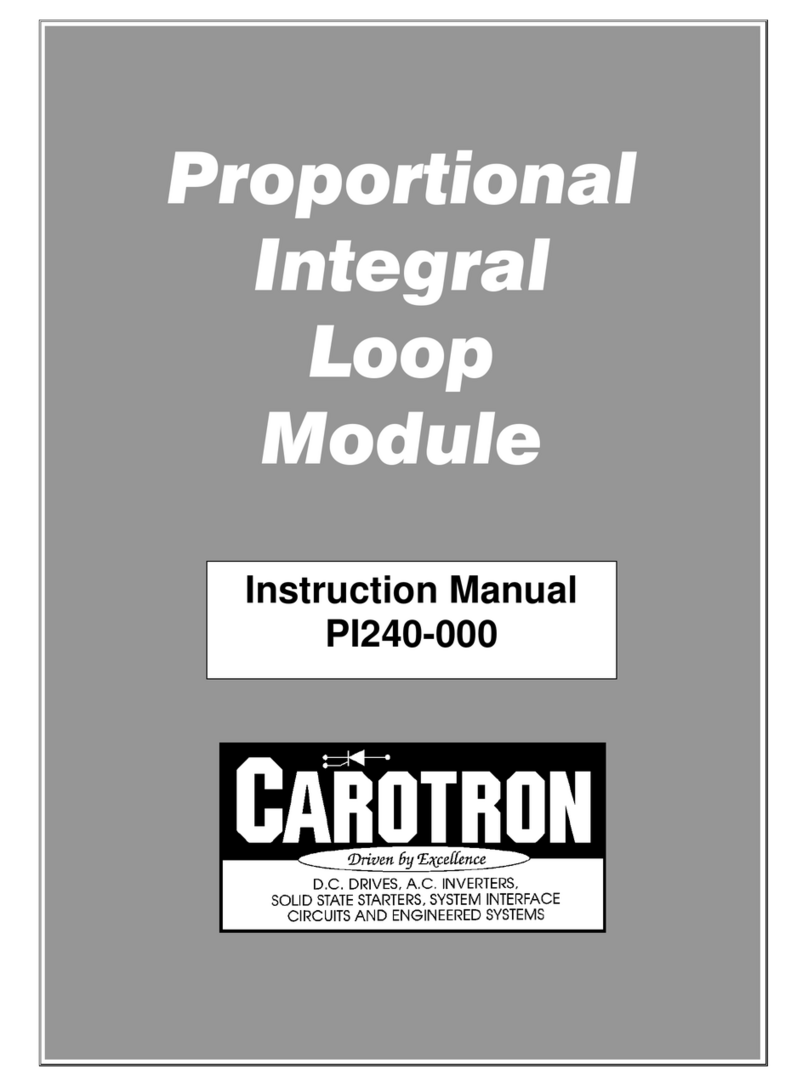
Carotron
Carotron PI240-000 instruction manual
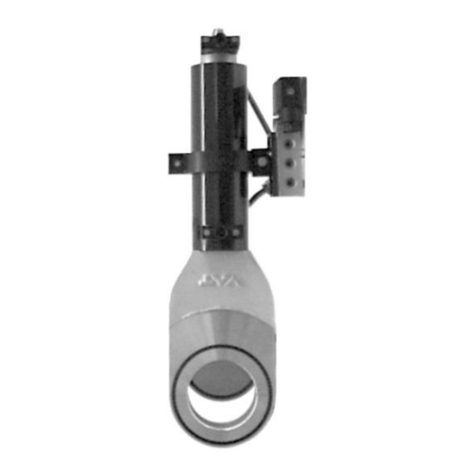
VAT
VAT 08 Series Installation, operating and maintenance instructions
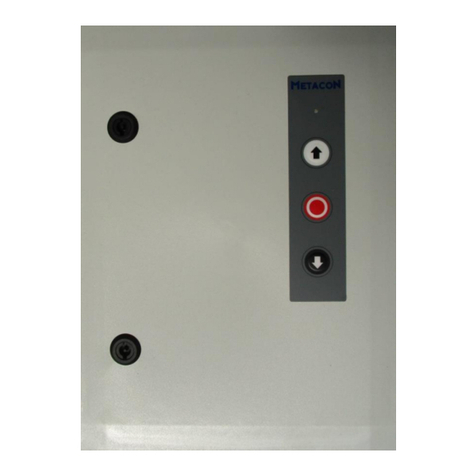
RDA
RDA FirePro V2 manual

HYDAC International
HYDAC International FCU 1000 Series Operating and maintenance instructions
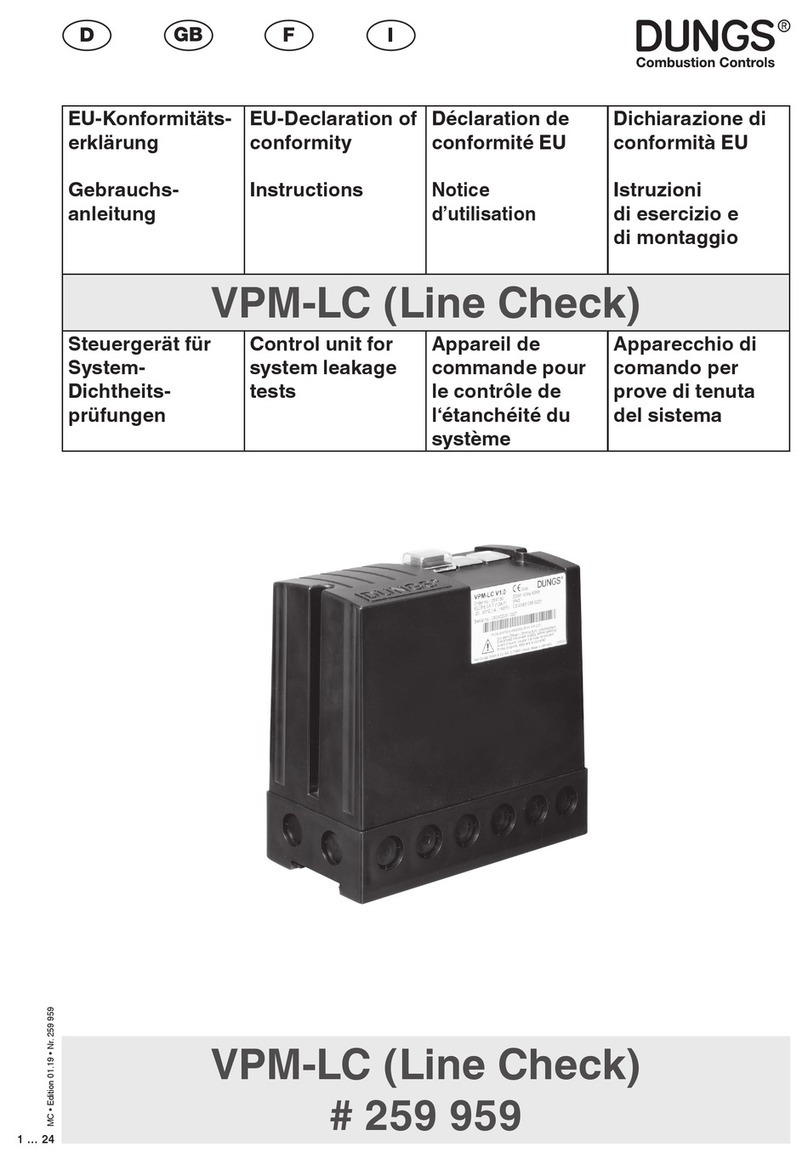
Dungs
Dungs VPM-LC instructions

Renesas
Renesas RYZ014A quick start guide
